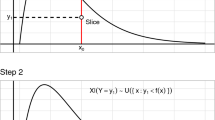Abstract
The estimation of the means of the bivariate normal distribution, based on a sample obtained using a modification of the moving extreme ranked set sampling technique (MERSS) is considered. The modification involves using a concomitant random variable. Nonparametric-type methods as well as the maximum likelihood estimation are considered. The estimators obtained are compared to their counterparts based on simple random sampling (SRS). It appears that the suggested estimators are more efficient. Also, MERSS with concomitant variable is easier to use in practice than the usual ranked set sampling (RSS) with concomitant variable. The issue of robustness of the procedure is addressed. Real trees data set is used for illustration.
Similar content being viewed by others
References
Al-Hadhrami, S. (2001). Parametric estimation using moving extreme ranked set sampling. Master thesis, Sultan Qaboos University, Oman.
Al-Odat, M. T. and Al-Saleh, M. F. (2001). A variation of ranked set sampling. Journal of Applied Statistical Science 10, 137–246.
Al-Saleh, M. F. (2004). Steady state ranked set sampling and parametric estimation. Journal of Statistical Planning and Inference 123(1), 83–95.
Al-Saleh, M. F. and Al-Hadhrami, S. (2003a). Parametric estimation for the location parameter for symmetric distribution using moving extreme ranked set sampling with application to trees data. Environmetrics 14(7), 651–664.
Al-Selah, M. F. and Al-Hadhrami, S. (2003b). Estimation of the mean of the exponential distribution using moving extreme ranked set sampling. Statistical Papers 44, 367–382.
Al-Saleh, M. F. and Al-Shrafat, K. (2001). Estimation average milk yield using RSS. Environmetrics 12, 395–399.
Al-Saleh, M. F. and Zheng, G. (2002). Estimation of bivariate characteristics using ranked set sampling. The Australian and New Zealand Journal of Statistics 44 221–232.
Al-Saleh, M. F. (1994). Mill's Ratio-A Bayesian approach. Pakistan Journal of Statistics 10, 629–632.
Arnold, B., Balakrishnan, N. and Nagaraja, H. (1992). A first course in order statistics. John Wiley and Sons, New York.
Halls, L. and Dell, T. (1966). Trials of ranked set sampling for forage yields. Forest Science 12, 22–26.
Kaur, A., Patil, G.P., Sinha, A.K. and Taillie, C. (1995). Ranked set sampling: An annotated bibliography. Environmental and Ecological Statistics 2, 25–54.
Lehmann, E. (1983). Theory of point estimation. John Wiley and Sons, New York.
Lehmann, E. (1966). Some concepts of dependence. Annals of Mathematical Statistics 37, 1137–1153.
Lindsey, J. (1999). Multivariate elliptically contoured distributions for repeated measurements. Biometrics 55, 1277–1280.
Barabesi, L. and Pisani, C. (2004). Steady-state ranked set sampling for replicated environmental sampling designs. Environmetrics 15, 45–56.
Martin, W., T. Oderwald, R. and Smith, D. (1980). Evaluation of RSS for estimating shrub phytomass in appalacachian oak forest. School of Forest and Wildlife Resources, Virginia Polytechnic Institute and State University.
McIntyre, G. (1952). A method for unbiased selective sampling using ranked set sampling. Australian Journal of Agricultural Research 3, 385–390.
Mehrotra, K. and Nanda, P. (1974). Unbiased estimation of parameters by order statistics in the case of censored samples. Biometrika 61, 601–606.
Mode, N. Conquest, L. and Marker, D. (1999). Ranked set sampling for ecological research: accounting for the total cost of sampling. Environmetrics 10, 179–194.
Nahhas, R., Wolf, D. and Chen, H. (2004). Ranked set sampling: Ranking error models and estimation of visual judgment error variance. Biometrical Journal 46, 255–263.
Patil, G., Sinha, A., and Taillie, C. (1994). Ranked set sampling for multiple characteristics. International Journal for Ecology and Environmental Sciences 20, 357–373.
Patil, G., Sinha, A., and Taillie, C. (1999). Ranked set sampling: Bibliography. Environmental and Ecological Statistics 6, 91–98.
Prodan, M. (1968). Forest Biometrics. Program Press, London.
Samawi, H. and Al-Saleh, M. F. (2004). On bivariate ranked set sampling for quantile estimation and quantile interval estimation using ratio estimator. Communications in Statistics-Theory and Methods 33, 1801–20.
Samawi, H., Ahmad, M. and Abu-Dayyeh, W. (1996). Estimating the population mean using extreme ranked set sampling. Biometrical Journal 30, 577–586.
Stokes, S. (1977). Ranked set sampling with concomitant variables. Communications in Statistics-Theory and Methods 6, 1207–1211.
Stokes, S. (1980). Inferences on the correlation coefficient in bivariate normal populations from ranked set samples. Journal of the American Statistical Association 75, 989–995.
Takahasi, K. Wakimoto, K. (1968). On unbiased estimates of the population mean based on the sample stratified by means of ordering. Annals of the Institute of Statistical Mathematics 20, 1–31.
Yang, S. (1977). General distribution theory of the concomitants of order statistics. Annals of Statistics 5, 996–1002.
Zheng, G. and Al-Saleh, M. F. (2002). Modified maximum likelihood estimator based on ranked set sampling. Annals of the Institute of Statistical Mathematics 54 641–6.
Author information
Authors and Affiliations
Rights and permissions
About this article
Cite this article
Al-Saleh, M.F., Al-Ananbeh, A.M. Estimation of the means of the bivariate normal using moving extreme ranked set sampling with concomitant variable. Statistical Papers 48, 179–195 (2007). https://doi.org/10.1007/s00362-006-0325-8
Received:
Revised:
Issue Date:
DOI: https://doi.org/10.1007/s00362-006-0325-8



